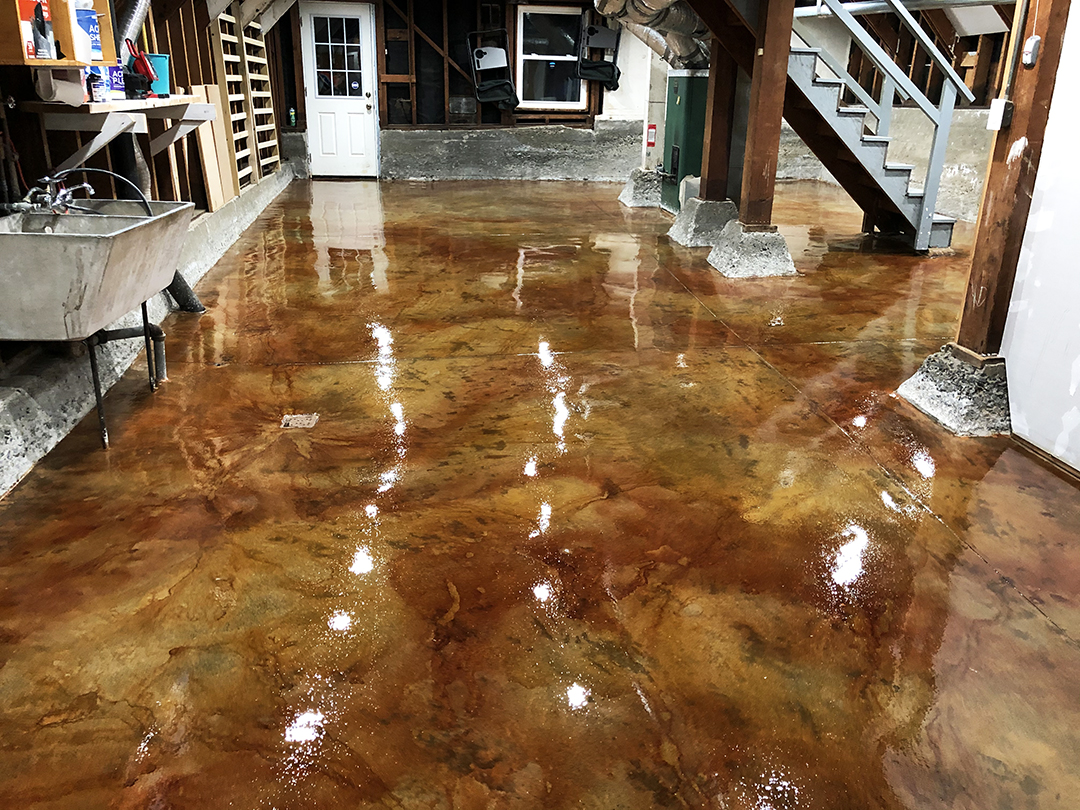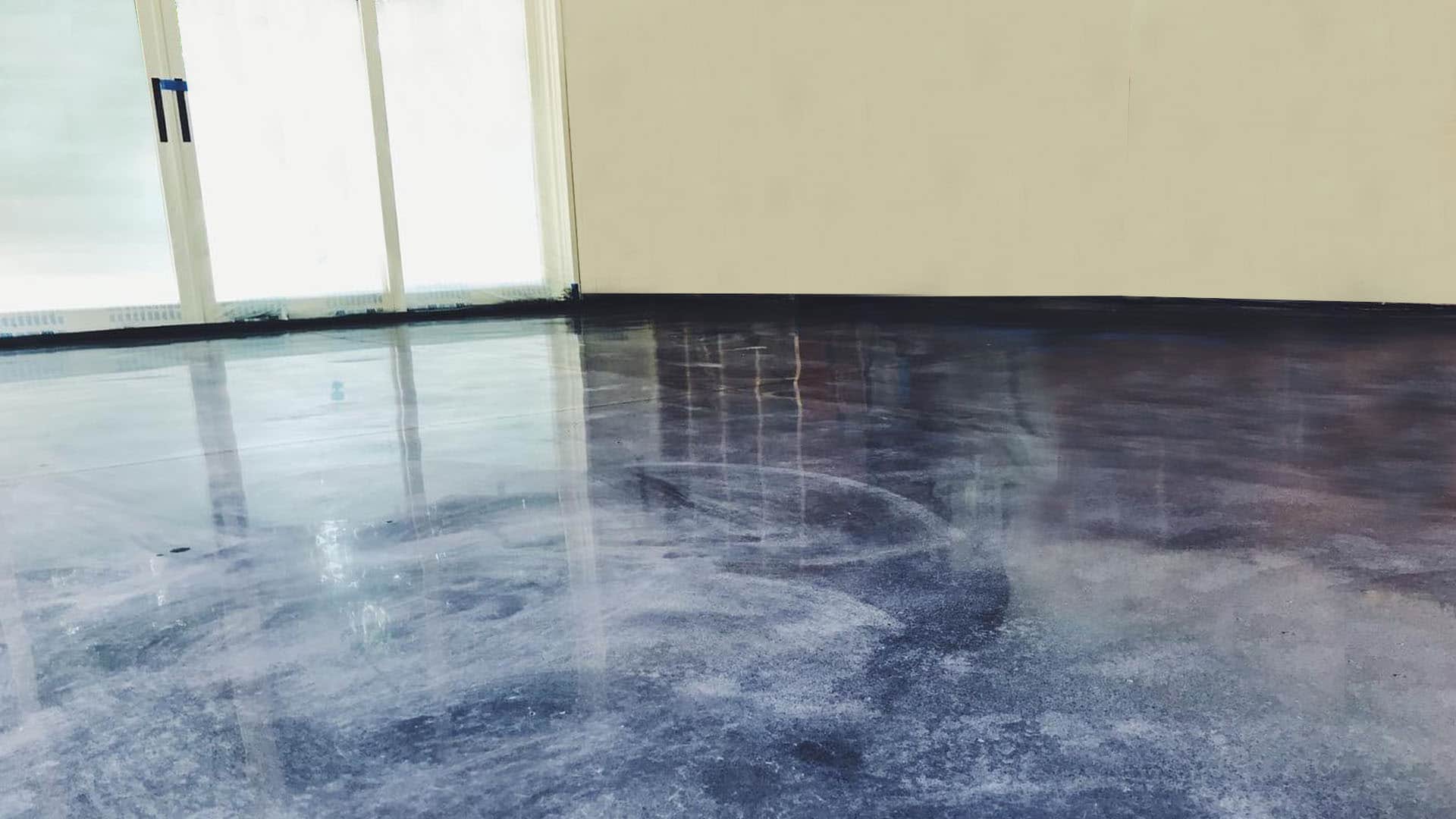The step-by-step process of staining stained concrete floors austin texas
Wiki Article
Comprehending the Various Kinds of Stained Concrete for Your Next Task
Stained concrete offers various choices that cater to various visual and functional needs. Each type presents distinctive characteristics that influence the final look and durability of the surface area. Recognizing these differences is crucial for any individual intending a project. From rich, chain reactions of acid-based stains to the dynamic harmony of strong shade stains, the options can greatly affect the result. What variables should one think about when picking the perfect stain for their specific requirements?Overview of Stained Concrete
Stained concrete acts as a flexible floor covering option that can enhance the aesthetic charm of different spaces. This strategy involves applying a tinting agent to the surface of existing concrete, permitting a broad spectrum of style opportunities. Stained concrete is preferred in both property and industrial settings, using a resilient and low-maintenance option that can imitate the look of natural products like stone or tile.The discoloration procedure can be implemented using water-based or solvent-based products, each offering unique aesthetic effects. The final appearance is affected by aspects such as the initial concrete surface, the kind of stain utilized, and the application approach. Stained concrete not only enhances exterior and interiors but also promotes sustainability by renewing existing concrete frameworks. Consequently, it has gotten traction amongst property owners and designers seeking both capability and style in their flooring selections.
Acid-Based Stains: Characteristics and Benefits

Special Shade Variations
Concrete surfaces can change significantly with the application of acid-based stains, which offer a rich palette of one-of-a-kind color variations. These stains permeate the concrete, reacting chemically to generate lively planet tones that vary from deep browns and reds to soft greens and blues. The resulting hues are typically variegated, developing a natural, marble-like look that enhances the concrete's personality. Each application yields distinct outcomes because of variations in the concrete's composition and the discoloration technique used, making every task unique. In addition, acid-based stains can be layered or integrated with various other techniques to create personalized layouts, enabling for individual expression. This versatility makes acid-based stains a popular choice for both domestic and business applications.Chemical Responses Explained
While several aspects contribute to the effectiveness of acid-based stains, the underlying chemical responses play a vital function in their special characteristics and benefits. These stains mainly consist of water, acid, and metal salts. When applied to concrete, the acid reacts with the calcium hydroxide in the cement, developing a chemical makeover that results in irreversible shade adjustments. The metallic salts penetrate the surface area and bond with the concrete, enabling a vast range of shades and tones. This reaction not just boosts visual charm but additionally offers resilience, making the color immune to fading and wear. Furthermore, acid-based stains can create a variegated finish that mimics natural stone, further boosting their popularity for ornamental concrete applications.Surface Area Preparation Relevance
Achieving perfect results with acid-based stains rests on detailed surface area preparation. This essential action guarantees that the concrete surface is clean, devoid of pollutants, and correctly profiled for perfect stain absorption. Any existing sealers, dirt, or oils can impede the chemical response that produces the wanted color and surface, causing unequal or irregular results.Before applying the tarnish, the concrete should be mechanically cleaned up or pressure washed, adhered to by a detailed inspection for fractures or imperfections that may need repair work. In addition, verifying the surface area is appropriately dried will certainly boost stain adherence. By focusing on these primary procedures, the longevity and vibrancy of acid-based stains can be substantially enhanced, resulting in a more visually pleasing and resilient coating.
Water-Based Stains: Functions and Benefits

Water-based stains penetrate the concrete, using a much more transparent coating that highlights the all-natural texture and variants of the surface area below. They are offered in a large range of shades, enabling for imaginative flexibility in style. In addition, water-based stains are simpler to tidy up, needing just water and soap, which simplifies the application process.
Their quick drying time boosts efficiency, making them a functional option for both do it yourself enthusiasts and specialists. In general, water-based stains supply an attractive mix of visual adaptability and easy to use residential or commercial properties, making them a preferred option for concrete enhancement tasks.
Solid Color Stains: Dynamic Options for a Bold Appearance
Solid color stains use an efficient service for those looking for to develop a vibrant and lively aesthetic on concrete surfaces. These stains offer a consistent coloration that browse around here can drastically improve the visual charm of floors, patio areas, and driveways. Offered in a broad range of tones, solid shade stains enable imaginative expression, providing to various design preferences.Among the crucial benefits of solid shade stains is their capability to hide blemishes, supplying a fresh and refined appearance to aging concrete - Stained Concrete Floors Austin Texas. Additionally, their formula typically consists of UV-resistant homes, making certain long life and color retention also in rough weather
Application is straightforward, calling for marginal preparation of the concrete surface area. As soon as used, strong color stains can be sealed for included protection and sheen, more elevating their aesthetic top quality. With their lively options, solid color stains are an exceptional choice for those intending for an impactful and cohesive design.
Semi-Transparent Stains: Achieving Deepness and Measurement
Semi-transparent stains use an unique method to enhancing concrete surfaces by providing deepness and measurement with numerous color choices. Understanding the application strategies is important for attaining the desired effect, while appropriate maintenance practices ensure long life. This area will check out these crucial elements to make best use of the advantages of semi-transparent staining.Color Options Available
A wide array of color alternatives exists for semi-transparent stains, allowing house owners and designers to enhance the all-natural elegance of concrete surfaces. These stains come in an array of colors, from natural tones like browns and terracottas to vibrant colors such as blues and eco-friendlies. The semi-transparent nature of these stains permits the underlying concrete to show via, developing an one-of-a-kind deepness and dimension that can enhance different design looks. Additionally, incorporating different shades can create customized tones, allowing a customized seek each project. This flexibility makes semi-transparent stains a prominent option for both indoor and exterior applications, as they can harmonize with surrounding components while adding visual interest to plain concrete.Application Methods Described
To achieve the preferred depth and measurement with semi-transparent stains, appropriate application methods are necessary. Initially, surface area preparation is critical; the concrete should be clean and devoid of any contaminants. This frequently entails power cleaning and fixing any cracks. Next off, choosing the appropriate applicator, such as a sprayer, roller, or brush, can affect the last appearance. Sprayers permit a much more even application, while rollers can aid accomplish texture. It is essential to use the tarnish in thin, also coats, allowing each layer to completely dry prior to adding another. Manipulating the application strategy, such as differing stress or utilizing various tools, can create unique effects. Ultimately, securing the stained surface boosts the vibrancy of the colors while giving defense.Upkeep Best Practices
Normal upkeep is vital for protecting the elegance and stability of surfaces treated with semi-transparent stains. To maintain these surfaces, regular cleaning is important. Using a pH-neutral cleaner and a soft-bristle broom will certainly aid remove dust and particles without harming the stain. It is a good idea to prevent rough chemicals, as they can deteriorate the stain's appearance. In addition, regular resealing every one to 3 years can protect against wear and fading. This process includes cleansing the surface area extensively and using a suitable sealer made for stained concrete. Home owners need to additionally check for any type of indicators of discoloration or damages and address these concerns promptly to ensure durable vibrancy and durability. Complying with these ideal techniques will certainly boost the overall life expectancy of semi-transparent stained surface areas.Effects and Techniques: Personalizing Your Stained Concrete
Tailoring stained concrete includes an array of techniques read what he said that enhance both aesthetic appeals and capability. Among these approaches, layering different tarnish colors can create deepness and complexity, enabling unique visual effects. Methods such as acid discoloration give a variegated appearance, while water-based stains offer a more consistent appearance.Furthermore, incorporating attractive patterns, such as stenciling or inscription, can further customize the surface, including intricate styles that satisfy specific preferences. Texturing the concrete, whether with stamping or mop finishes, presents tactile aspects that not only boost grip however likewise improve aesthetic rate of interest.
Applying sealants can amplify the shade vibrancy and give security against wear. Modification strategies extend beyond mere shade; they can change a standard concrete slab into a stunning prime focus, making it appropriate for both household and industrial spaces. Via cautious choice of impacts and techniques, stained concrete can accomplish a truly tailored appearance.
Upkeep and Durability of Stained Surfaces
Although stained concrete surface areas are recognized for their longevity and aesthetic allure, preserving their stability is essential for making certain durability. Routine cleansing is vital; sweeping and mopping with a pH-neutral cleaner helps prevent dirt buildup and discoloration. find here Additionally, applying a sealer every few years can secure the surface from moisture, chemicals, and UV damages, therefore enhancing its life expectancy.It is likewise important to resolve any kind of cracks or chips quickly. Small repair services can alleviate further degeneration, protecting the visual and architectural high quality of the surface. For outdoor stained concrete, seasonal upkeep, such as removing snow and ice, is needed to avoid surface damage from freeze-thaw cycles.
Often Asked Concerns
Can I Tarnish Existing Concrete Surfaces or Only Brand-new Ones?
The question of whether existing concrete surfaces can be stained occurs frequently. It is indeed possible to tarnish both new and old concrete, provided the surface area is effectively ready and without pollutants for ideal adhesion.How much time Does the Staining Refine Typically Take?
The discoloration procedure generally takes one to 3 days, relying on factors such as surface preparation, kind of tarnish, and climate condition. Stained Concrete Floors Austin. Healing time might extend past first application, affecting the overall duration substantiallyIs Stained Concrete Safe for Outdoor Use?
Stained concrete is normally safe for exterior usage, provided it is appropriately sealed. This sealing protects versus dampness and UV damage, making sure durability and safety, while likewise boosting the visual appeal of exterior spaces.Can I Apply Several Discoloration Layers for Different Effects?
Applying several stain layers can attain varied effects on stained concrete. It is vital to assure compatibility between stains and allow appropriate drying time between applications to stay clear of unexpected reactions or discoloration.Exist Any Color Limitations for Stained Concrete?
Color limitations for stained concrete largely depend on the sort of stain made use of, with water-based stains providing a more comprehensive scheme contrasted to acid-based stains. Stained Concrete Austin. Attaining lively shades may require mindful option and application strategies.Report this wiki page